vitpho/iStock via Getty Images
Lumber is a crucial construction ingredient, making it a bellwether industrial raw material. Lumber trades on the futures market, but it’s one of the most illiquid contracts in the commodities asset class. Lumber tends to reflect the growth or contraction in the new home market. Therefore, wood’s price is closely correlated with interest rates. As mortgage rates increase, the demand for new homes tends to decline and vice versa, impacting lumber’s price.
Meanwhile, the lack of broad participation in lumber futures makes the market susceptible to price explosions and implosions. Bids or offers tend to evaporate in futures markets with low levels of open interest and volume. Open interest is the total number of open long and short positions in a futures market. Volume is the number of contracts that change hands between buyers and sellers.
During the week of March 30, 2020, as the impact of the spreading global pandemic caused selling in markets across all asset classes, lumber futures fell to a low of $251.50 per 1,000 board feet. Fourteen months later, historically low interest rates, the demand for new homes, supply chain bottlenecks, and slowdowns or shutdowns at lumber mills drove the price over 6.8 times higher to a record peak at $1711.20 per 1,000 board feet.
The iShares S&P Global Timber & Forestry Index ETF product (NASDAQ:WOOD) follows the price of lumber higher and lower. However, they tend to underperform the wild volatility in the lumber futures arena on the upside and outperform during price corrections because they are more liquid than the futures.
Lumber moved from a parabolic rally to a falling knife in 2021. The price range for the year has been from $448 to $1,711.20 per 1,000 board feet.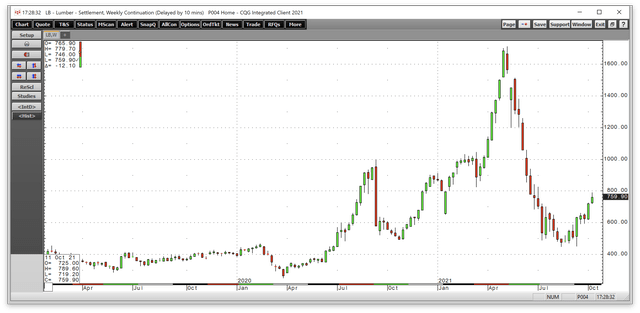
Source: CQG
The weekly chart shows the move that took lumber to a record high during the week of May 10 before collapsing to under one-third the price by mid-August.
The head-spinning price action was enough to erase any thoughts of participating in the lumber futures market at any time. Open interest, the total number of open long and short positions in the lumber market, has not been above the 3,411-contract level in 2021. At the end of last week, it stood at only 2,043 contracts after falling to a low of 1,673 on Sept. 20. The low level of market participation created wild price swings. A risk position on the wrong side of the lumber market can be excruciating.
After plunging by 73.8% in three short months, lumber reached the 2021 low.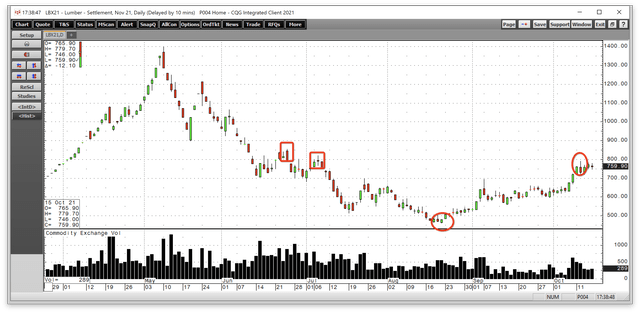
Source: CQG
While the continuous contract traded to a low of $448 in August, the active month November futures contract low was at $462 per 1,000 board feet. Before 2017, the all-time high in lumber futures came in 1993 at $493.50. In August, the wood price fell just below that level before recovering.
Over the past weeks, lumber has made a series of higher lows and higher highs, reaching the latest peak at $789.60 per 1,000 board feet on October 12. The November contract settled at $759.90 on Friday, October 15, as the trend remained bullish at the end of last week. Lumber futures remain highly illiquid as they have not traded over 1,000 contracts in a day since late June. On October 15, only 289 lumber futures contracts changed hands.
I view the lumber futures arena as a barometer for other commodity prices. The wood price has a habit of rising for falling before the rest of the asset class. Most recently, lumber’s rally began in mid-August when crude oil found a bottom and began its climb to a multi-year high. 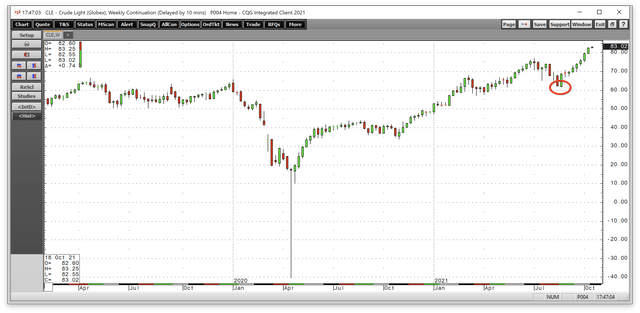
Source: CQG
The chart shows lumber made a low one week before crude oil found a bottom and put in a bullish reversal pattern on the weekly chart as the price rejected the $61.74 per barrel low. Meanwhile, copper fell to its low during the same week lumber bottomed. 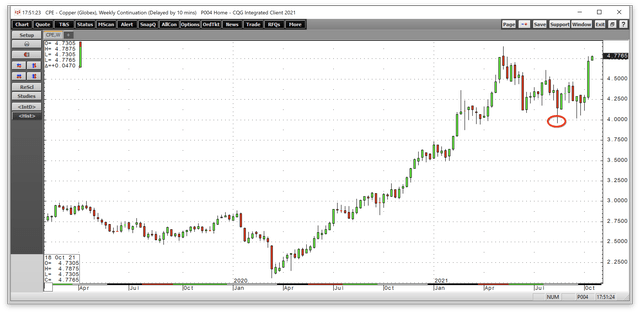
Source: CQG
Copper futures probed under the $4 per pound level in mid-August. At the end of last week, copper, crude oil, and lumber recovered with the energy commodity and metal near a multi-year and all-time high, respectively.
Lumber, oil, and copper are industrial commodities. Four factors point to more gains over the coming weeks, months, and perhaps, years:
Even the most aggressive bull markets rarely move in straight lines. Bull market corrections can be brutal, as we witnessed in lumber and copper from May through August. Lumber fell by nearly 74%, and copper plunged by over 19%. Crude oil experienced a 19.8% downdraft from early July through the late August low. Meanwhile, all three industrial commodities have made impressive comebacks since the August bottoms, and the trends remained higher at the end of last week.
I have no problem trading in the wildest markets. Elevated price variance increases opportunities. Since risk is always a function of rewards, I adjust my parameters based on a market’s volatility. Meanwhile, the one factor that is critical for participation is liquidity. The ability to open and close risk positions on relatively a tight bid-offer spread is crucial. Lumber fails the liquidity test. Traders call markets like lumber “roach motels,” as it’s easy to get into the wrong position but impossible to get out without suffering a massive loss.
I have bought and sold futures and other derivatives in almost every commodity you can imagine over the past four decades, but I have never traded even one lumber contract, and I never will.
Meanwhile, I watch the price action in the wood futures arena like a hawk as it often provides clues or validation for risk positions in other raw material markets. I have used proxies that tend to underperform lumber futures on the upside but outperform when the price plunges when it comes to the lumber market.
The fund summary for the iShares Global Timber & Forestry ETF product states: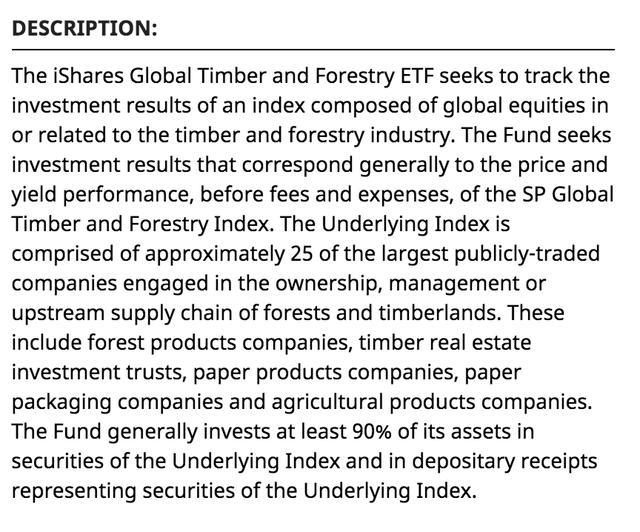
Source: Barchart
WOOD’s top holdings include: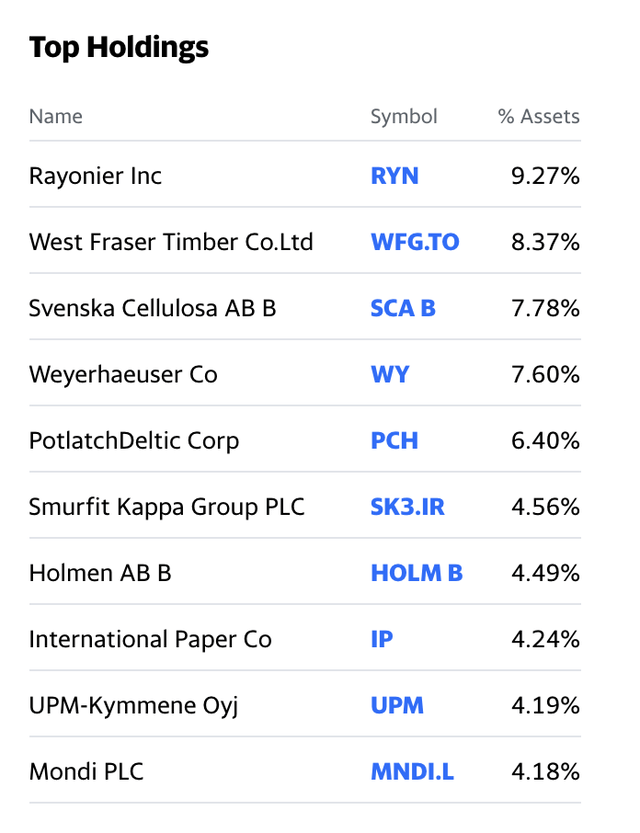
Source: Yahoo Finance
At $86.82 per share on October 15, WOOD had $304.465 mullion in assets under management. The ETF trades an average of 22,215 shares each day and charges a 0.46% management fee.
Nearby lumber futures rose from $495 per 1,000 board feet in November 2020 to a high of $1711.20 in May 2021 as they more than tripled in price. The decline to $448 in August took the price 73.8% lower. The most recent rally to $759.90 was a 69.6% recovery as of the end of last week.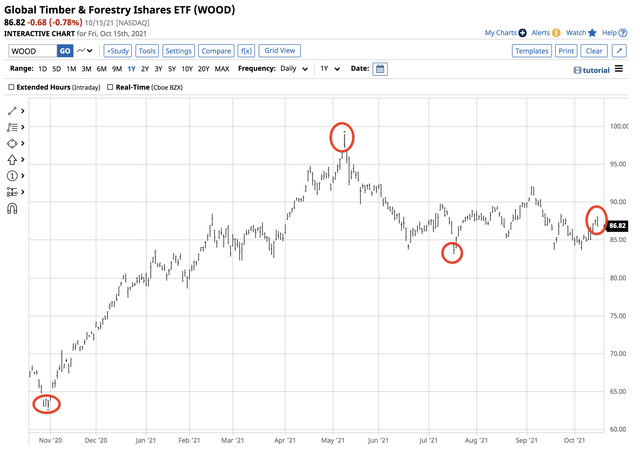
Source: Barchart
The chart shows the WOOD ETF rose from a low of $62.91 in November 2020 to a high of $98.98 per share in May 2021, or 57.3%. It then fell to a low of $83.14 or 16% in July before recovering to $86.82 at the end of last week, a 4.4% rise from the low.
WOOD tracks the lumber futures price over time, but it underperforms on the upside and outperforms during periods of price carnage.
I do not have the stomach, courage, or delusion to trade lumber futures, but I watch them closely. Meanwhile, WOOD is a proxy for the illiquid market that allows me to sleep at night. At the end of last week, the trend in the lumber futures arena was higher, so I favor a long position in the WOOD ETF. Meanwhile, the $1.17 dividend equates to a 1.35% yield at $86.82 in the WOOD product.
The Hecht Commodity Report is one of the most comprehensive commodities reports available today from a top-ranked author in commodities, forex, and precious metals. My weekly report covers the market movements of over 20 different commodities and provides bullish, bearish and neutral calls; directional trading recommendations, and actionable ideas for traders.
This article was written by
Andy spent nearly 35 years on Wall Street, including two decades on the trading desk of Phillip Brothers, which became Salomon Brothers and ultimately part of Citigroup.
Disclosure: I/we have no stock, option or similar derivative position in any of the companies mentioned, and no plans to initiate any such positions within the next 72 hours. I wrote this article myself, and it expresses my own opinions. I am not receiving compensation for it (other than from Seeking Alpha). I have no business relationship with any company whose stock is mentioned in this article.
Additional disclosure: The author always has positions in commodities markets in futures, options, ETF/ETN products, and commodity equities. These long and short positions tend to change on an intraday basis.


